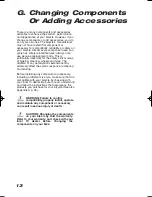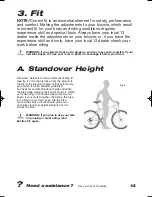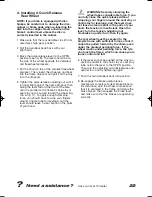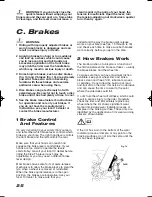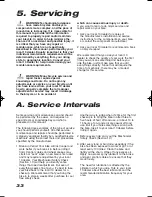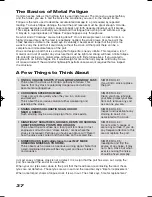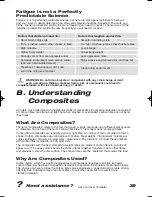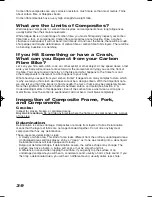
3 Brake Power
Modulators
Some V brakes have a brake modulator fitted in
the control cable. This reduces the severity of the
application of the brakes, helping the rider to
achieve a smooth safe stop. Modulators are non
adjustable and do not require any specific
maintenance.
4 Brake Blocks
And Pads
Brake blocks must be replaced when they have
worn to the base of the grooves in the friction
surface. Disc brake pads must be replaced when
the friction material has worn to a thickness of
0.5 mm (minimum of 1mm for Shimano pads).
Your multi-speed bicycle will have a derailleur
drive train or an internal gear hub drive train.
1 How a Derailleur
Drive Train Works
If your bicycle has a derailleur drive train, the
gear-changing mechanism will have:
• a rear cassette or freewheel sprocket cluster
• a rear derailleur
• usually a front derailleur
• one or two shifters
• one, two or three front sprockets called
chainrings
• a drive chain
a. Shifting Gears
Your multi-speed bicycle will either have a
derailler drive train or an internal gear hub drive
train. There are several different types and styles
of shifting controls: levers, twist grips, triggers,
combination shift/brake controls and push
buttons. Ask your
local 13 dealer
to
explain the
type of shifting controls that are on
your bike, and
to show you how they work.
The vocabulary of shifting can be pretty
confusing. A
downshift is a shift to a “lower” or
“slower” gear, one which is easier to pedal. An
upshift is a shift to a “higher” or “faster”, harder to
pedal gear. What’s confusing is that what’s
happening at the front derailleur is the opposite
of what’s happening at the rear derailleur (for
details, read the instructions on Shifting the Rear
Derailleur and Shifting the Front Derailleur
below). For example, you can select a gear
which will make pedaling easier on a hill (make a
downshift) in one of two ways: shift the chain
down the gear “steps” to a smaller gear at the
front, or up the gear “steps” to a larger gear at
the rear. So, at the rear gear cluster, what is
called a downshift looks like an upshift. The way
to keep things straight is to remember that
shifting the chain in towards the centreline of the
bike is for accelerating and climbing and is called
a downshift. Moving the chain out or away from
the centreline of the bike is for speed and is
called an upshift.
Whether upshifting or downshifting, the bicycle
derailleur system design requires that the drive
chain be moving forward and be under at least
some tension. A derailleur will shift only if you are
pedaling forward.
CAUTION: Never move the shifter
whilst stationary, whilst pedalling
backwards, or pedal backwards immediately
after having moved the shifter. This could
jam the chain and cause serious damage to
the bicycle.
b. Shifting the Rear Derailleur
The rear derailleur is controlled by the right
shifter. The function of the rear derailleur is to
move the drive chain from one gear sprocket to
another. The smaller sprockets on the gear
cluster produce higher gear ratios. Pedaling in
the higher gears requires greater pedaling effort,
but takes you a greater distance with each
revolution of the pedal cranks. The larger
sprockets produce lower gear ratios. Using them
requires less pedaling effort, but takes you a
shorter distance with each pedal crank
revolution. Moving the chain from a smaller
sprocket of the gear cluster to a larger sprocket
results in a downshift. Moving the chain from a
larger sprocket to a smaller sprocket results in an
upshift. In order for the derailleur to move the
chain from one sprocket to another, the rider
must be pedaling forward.
D. Shifting Gears
27
13
owners manual GENERIC A5 aw
05/05/14
10:25 Page 29

